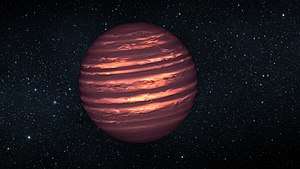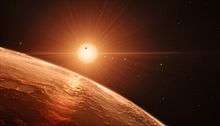OGLE-2016-BLG-1190Lb
| Exoplanet | List of exoplanets | |
|---|---|---|
 | ||
| Parent star | ||
| Star | OGLE-2016-BLG-1190L[1] | |
| Constellation | Sagittarius | |
| Right ascension | (α) | 17h 58m 53.0s[2] |
| Declination | (δ) | −27° 36′ 49″[2] |
| Distance | 22,000[3] ly (6770.0[2] pc) | |
| Spectral type | G-dwarf star[3] | |
| Mass | (m) | 0.88[2] M☉ |
| Physical characteristics | ||
| Mass | (m) | 13.38[1][2] MJ |
| Orbital elements | ||
| Semi-major axis | (a) | 2.17[2] AU |
| Eccentricity | (e) | 0.42[2] |
| Orbital period | (P) | 1223.6 [2] d |
| Inclination | (i) | 41.2[2]° |
| Time of transit | (Tt) | 2456989.8 (?)[2] JD |
| Discovery information | ||
| Discovery date | 2017[1] | |
| Discoverer(s) | Ryu, Y.-H. et al[1] | |
| Discovery method | Gravitational microlensing[1] | |
| Discovery site | Spitzer Space Telescope[1] | |
| Discovery status | Published[1] | |
| Database references | ||
| Extrasolar Planets Encyclopaedia | data | |
| SIMBAD | data | |
| Exoplanet Archive | data | |
| Open Exoplanet Catalogue | data | |
OGLE-2016-BLG-1190Lb is an extremely massive extrasolar planet, with a mass about 13.4 times that of Jupiter (MJ), or is, possibly, a low mass brown dwarf, orbiting the G-dwarf star OGLE-2016-BLG-1190L, located about 22,000 light years from Earth, in the constellation of Sagittarius, in the galactic bulge of the Milky Way.[1][3][4]
“Since the existence of the brown dwarf desert is the signature of different formation mechanisms for stars and planets, the extremely close proximity of OGLE-2016-BLG-1190Lb to this desert raises the question of whether it is truly a ‘planet’ (by formation mechanism) and therefore reacts back upon its role tracing the galactic distribution of planets," according to astronomers reporting the findings.[1][5]
Discovery
The host star was discovered in June 2016 by the Optical Gravitational Lensing Experiment (OGLE) collaboration; the Spitzer Space Telescope observed the microlensing event a few days after its discovery. OGLE-2016-BLG-1190Lb is the first exoplanet discovered by microlensing with the Spitzer space telescope and the first exoplanet discovered lying near the planet/brown dwarf boundary.[1][3] In addition, the discovery "is likely to be the first Spitzer microlensing planet in the Galactic bulge/bar," according to the initial reported study.[1]

See also
References
- 1 2 3 4 5 6 7 8 9 10 11 Ryu, Y.-H.; et al. (27 October 2017). "OGLE-2016-BLG-1190Lb: First Spitzer Bulge Planet Lies Near the Planet/Brown-Dwarf Boundary". arXiv:1710.09974 [astro-ph.EP].
- 1 2 3 4 5 6 7 8 9 10 Staff (2017). "Planet OGLE-2016-BLG-1190L b". Extrasolar Planets Encyclopaedia. Retrieved 10 November 2017.
- 1 2 3 4 Nowakowski, Tomasz (6 November 2017). "Extremely massive exoplanet discovered in the Milky Way's bulge". Phys.org. Retrieved 10 November 2017.
- ↑ Bartels, Meghan (7 November 2017). "A Giant Exoplanet Is Hiding At The Center of the Milky Way Galaxy". Newsweek. Retrieved 10 November 2017.
- ↑ Wehner, Mike (7 November 2017). "Astronomers just spotted a planet so huge they aren't even sure it's really a planet". BGR. Retrieved 10 November 2017.

